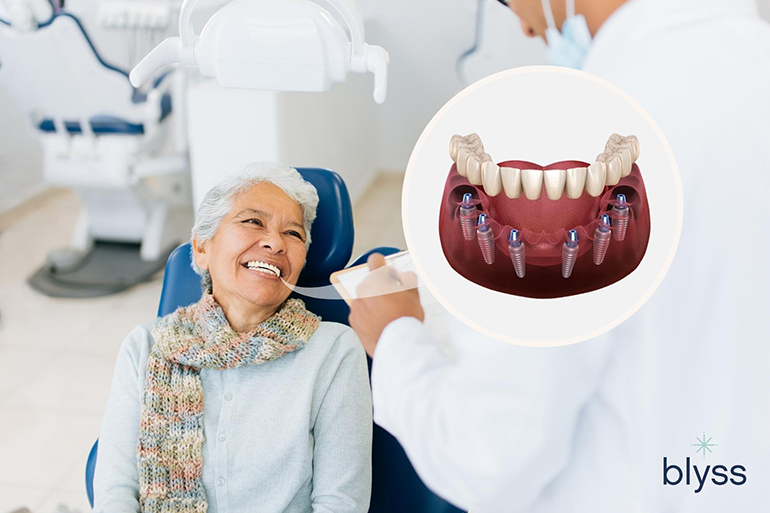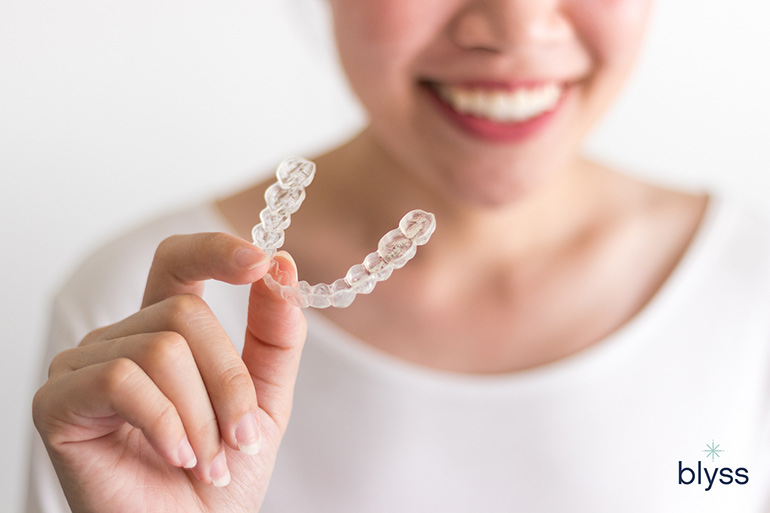You may have heard of All-on-4 dental implants, commonly known as teeth-in-a-day. But how about All-on-6 dental implants?
What’s the difference between the two? And which one is right for you? Let’s take a closer look.
All-On-6 Dental Implants vs. All-On-4: What’s the Difference?
All-on-6 dental implants are a permanent dental prosthetics that can replace an entire row of missing teeth.
All-on-6 dental implants get their name because they require six implants to be placed in the jawbone. All-on-4 implants, as you might have guessed, only require four.

The biggest (obvious) difference between the all-on-4 and all-on-6 dental implants is the number of implants placed in the jawbone.
This may not seem like a big difference, but it can significantly impact the procedure and the results.
Learn more about All-on-4 dental implants by reading this article: Top 8 Things to Consider When Getting All-on-4 Dental Implants
Who Needs All-On-6 Dental Implants?
All-on-6 dental implants are not for everyone. They are meant for people who have lost all of their teeth in their upper or lower jaw or both.
If you still have some healthy teeth left, you might be a candidate for traditional dental implants placed between your remaining teeth.
But if you’ve lost all of your teeth, All-on-6 implants are the way to go.
To be considered for All-on-6 dental implants, you must first meet the following criteria:
- You must have enough bone in your jaw to support the implants.
- Your gums must be healthy and free of gum disease.
- You must be willing to commit to good oral hygiene habits and regular dental visits.
- You must be in good overall health.
All-on-6 Dental Implants Tip: Contact Blyss Dental today to schedule a free consultation. I will help you determine if an All-on-6 procedure is right for you and answer any questions you may have about it.
Why Choose All-on-6 Dental Implants
All-on-6 is quite similar to All-on-4, which is why they offer the same benefits. However, there are a few key differences.
The All-on-6 method involves surgically attaching 6 implants rather than 4 in the upper and lower jaws. This may be a more suitable option for certain patients or cases based on individual needs.
Extra Stability
The All-on-6 protocol provides more strength and stability than the All-on-4 procedure.
Depending on the condition of a patient’s mouth, gums, and jawbone, it may be determined that they would benefit most from the additional two implants in an All-on-6 procedure.
Enhanced Jawbone Support
The All-on-6 system’s additional two implants help preserve jawbone density, protecting against bone loss in the long run. All-on-4 dental implants are placed on the front jawbone.
It doesn’t preserve as much bone in your molar areas. All-on-6 provides preservation of the jawbone since the extra two implants provide a wider area to preserve your jawbone in the back of your mouth.
In cases where patients are especially worried about bone density loss, this method can give them extra security and peace of mind that their replacement teeth will remain solid and secure for years to come.
Additionally, because they preserve your jawbone, implants help to keep your face from sagging or looking sunken in due to bone loss.
Enhanced Comfort
Because they are permanently anchored into your jawbone, All-on-6 implants offer enhanced comfort compared to other tooth replacement options.
You won’t have to worry about your teeth slipping out of place or rubbing against your gums, which can often be painful.
Improved Biting Function
Most of your biting forces are in your molar areas. All-on-6 dental implants improve chewing function because implants provide extra support in your molar areas.
This added support can lead to increased stability when eating and speaking and improved comfort.
More Teeth per Jaw
You can have a full set of 14 teeth per jaw with All-on-6 implants. You can only have 10 to 12 teeth per jaw with All-on-4. This provides extra chewing capacity and comfort. Think of chewing your steaks with a full set of teeth.
Still not convinced? Learn more by checking out the Pros and Cons of Dental Implants: Why You Should (or Shouldn’t) Get Them.
How Do All-on-6 Dental Implants Work?
Like All-on-4 Dental Implants, the All-on-6 dental implants are placed into the jawbone either in the upper or lower arch or both.
The difference is that with All-on-6, we place six implants instead of four. It allows us to spread out the load, so to speak, which can be beneficial for people with weaker jawbones or at risk for implant failure.
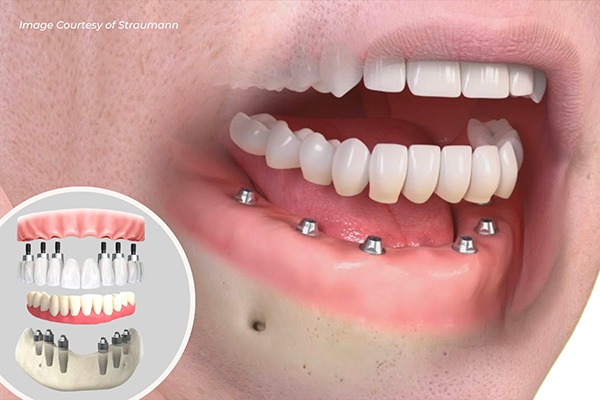
Because they replace your entire arch of teeth, All-on-6 implants provide a full set of teeth that look and function just like your natural teeth.
The steps involved in getting All-on-6 dental implants are as follows:
Step 1: Schedule a consultation with your dentist to see if you’re a good candidate for All-on-6 dental implants.
During the consultation, your dentist will assess your mouth to ensure you are a good candidate for All-on-6.
Your mouth will be physically examined, and X-rays and CT scans will be taken of your jawbone to determine its density and shape.
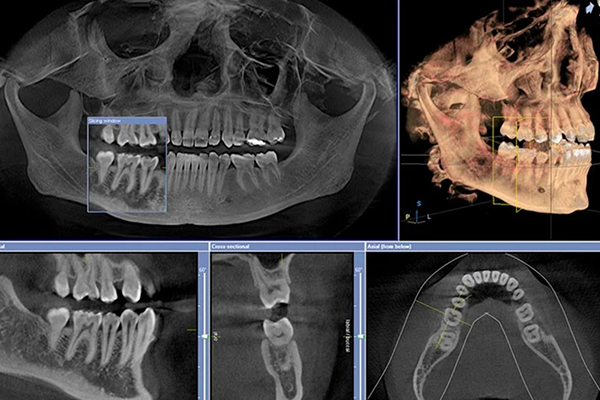
Without a CT scan to aid in the dental implant placement process, it is highly likely that the implants will be improperly positioned and lead to bone loss and failed surgery.
Your dentist will also ask about your medical history and whether you have any conditions that could affect implant success, such as uncontrolled diabetes or periodontal disease.
They will also check whether you need pre-treatment procedures such as teeth extractions and bone grafting.
All-on-6 Dental Implant Tip: A dentist who does not use computed tomography (CT) scans may be performing outdated implant placement techniques. To ensure that your dentist uses cutting-edge technology, ensure that your dentist requests 3D imaging of your jawbone.
Step 2: Have the All-on-6 implants placed in your jawbone.
Should you need pre-treatment procedures such as teeth extractions and bone grafting, they will be done before the implant surgery.
These procedures may be done separately or during the same session as the surgery.
Before the start of the surgery, your dentist will administer anesthesia to ensure your comfort during the procedure.
Usually, dentists make small incisions in your gums. But at Blyss Dental, I use an advanced technique called 3D Guided Implant Surgery.

The 3D surgical guide is used to insert the implants right into your jawbone without having to make incisions and stitches. It also allows for more precise and minimally invasive dental implant placement while avoiding errors. It also minimizes swelling after implant placement. Your recovery time is faster compared to traditional implant placement methods.
Six titanium implant posts will be placed into your jawbone. Once they’re in place, the incisions will be closed with stitches and left to heal.
Step 3: Allow the All-on-6 implant posts to fuse to your jawbone.
This recovery period is important as you allow the implant to fuse into your jawbone as it heals. This process, called osseointegration, usually takes 3-6 months.
During this time, you’ll need to follow your dentist’s post-operative instructions, including medications and temporary diet restrictions.
Step 4: Attach the implant abutments to the implant posts.
Once osseointegration is complete, metal abutments will be attached to the tops of the implant posts. These abutments will serve as anchors for your prosthetic teeth.
Your dentist will then take impressions of your mouth so your new teeth can be custom-made.
In the meantime, your dentist places a temporary prosthesis on your mouth so you won’t walk out of the clinic without teeth!
Step 5: Receive your new teeth and show off your smile!
Once your permanent custom-made prosthesis is completed, it will be securely attached to the abutments.
Your dentist will make sure you’re comfortable, and the All-on-6 procedure is working properly before declaring the procedure complete.
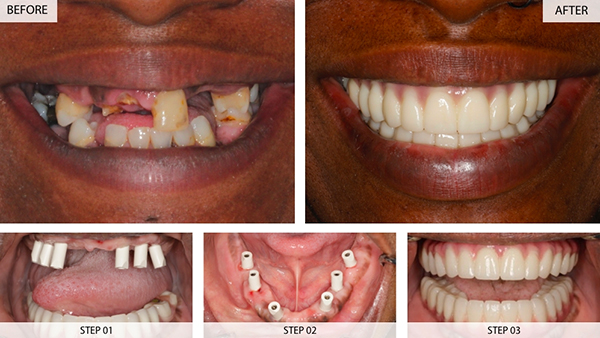
With multiple advantages over traditional dentures and bridges, dental implants offer a more comfortable, durable, and natural solution for replacing missing teeth.
What happens after the surgery? What’s the recovery period like? Read our related article Dental Implant Healing Stages: What To Expect After Getting A Dental Implant.
All-on-6 Dental Implants Cost in San Diego
A full mouth of dental implants typically costs between $40,000 and $80,000.
The cost of All-on-6 dental implants will vary depending on the oral surgeon or dentist you choose, the location of the practice, and the type of implant you need.
The dentist will require CT scans and X-rays during the consultation. You may also need teeth extractions and bone grafting, which adds to the cost.
All-on-6 Dental Implant Tip: At Blyss Dental in San Diego, we offer several payment options to make All-on-6 implants more affordable for our patients. We also offer a free consultation so that you can learn more about All-on-6 dental implants and decide if they are right for you.
Read our Dental Implant Cost Insider Tips 2022 and learn How to Save Up to $20,000 On Your Dental Implant Procedure.
Does Dental Insurance Cover the All-on-6 Procedure?
The answer is that it depends on your specific insurance plan. Some insurance plans may provide coverage for All-on-6 dental implants, while others may only provide partial coverage or no coverage at all.
How to Find Out if Your Dental Insurance Plan Covers All-on-6 Dental Implants
If you’re considering All-on-6 dental implants, the first step is to determine if your insurance plan provides any coverage for this procedure.
Most dental insurance does not cover full-arch dental implants. They only cover procedures such as traditional dentures.
They may cover preparatory procedures such as X-rays, extractions, and bone grafting.
All-on-6 Dental Implant Tip: Many of our patients are looking for implant dentistry in San Diego, but they don’t know if their dental insurance will cover the cost of treatment. Most dental insurance companies do not cover the cost of dental implants. However, at Blyss Dental, we work with many different financing options that can make treatment more affordable. Give us a call, and we can help you figure out the best way to finance your treatment.
Finding the Best Implant Dentist in San Diego
If you’re considering All-on-6 dental implants in San Diego, choosing an experienced and reputable implant dentist is important.
When you come to our office for a consultation, we will take the time to listen to your concerns and answer your questions. We will also thoroughly examine your mouth and jawbone to determine if All-on-6 dental implants are right for you.
If we determine that implants are not right for you, we will offer alternative treatment options that may be more suitable.
So if you’re considering All-on-6 dental implants in San Diego, contact Blyss Dental today to schedule a free consultation.
Sources Cited From
- Facts & Figures | American College of Prosthodontists. (n.d.). https://www.gotoapro.org/facts-figures/
- Cucchi, A., Vignudelli, E., Franco, S., Ghensi, P., Malchiodi, L., & Corinaldesi, G. (2019, December 27). Evaluation of Crestal Bone Loss Around Straight and Tilted Implants in Patients Rehabilitated by Immediate-Loaded Full-Arch All-on-4 or All-on-6: A Prospective Study. Allen Press. https://meridian.allenpress.com/
joi/article/ 45/6/434/423087/ Evaluation- of-Crestal-Bone -Loss-Around-Straight - GARGARI, M., PRETE, V., PUJIA, A., & CERUSO, F. M. (2013). Full-arch maxillary rehabilitation fixed on 6 implants. Oral & Implantology, 6(1), 1-4. https://doi.org/
https://www.ncbi.nlm.nih.gov/ pmc/ articles/ PMC3755809/
